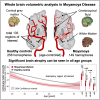Whole-brain volumetric analysis in adult Moyamoya patients reveals significant atrophy compared to healthy controls
- PMID: 40135070
- PMCID: PMC11934919
- DOI: 10.1093/braincomms/fcaf100
Whole-brain volumetric analysis in adult Moyamoya patients reveals significant atrophy compared to healthy controls
Abstract
Moyamoya disease (MMD) may lead to perfusion deficits, stroke and brain atrophy in the long-term. Our aim was to analyse whole-brain volumetry of a large cohort of Moyamoya disease patients compared to healthy controls. 3D T1w MRI sequences of adult Moyamoya disease patients treated at our centre between 2016 and 2022 without prior revascularization were analysed for whole-brain volumetry (AssemblyNet) and compared age-controlled to healthy controls. A total of 133 different regions of interest were examined retrospectively for each patient separately by localization, structure and tissue type. All segmentations were subjected to automated and manual quality control. After quality control, 149 hemispheres from 80 Moyamoya disease patients were compared to 258 hemispheres from 129 healthy controls. A significant brain volume loss was observed in Moyamoya disease patients with increasing age, with the greatest reduction seen in bilaterally affected patients with Suzuki grade >3. As direct signs of brain atrophy, significant differences were seen across all regions of interests, emphasized in cortical grey matter with a reduction of 4.4% (95% CI 2.7-6.1%; P < 0.001) in patients aged 30-45 years and 3.4% (95% CI 2.1-4.7%; P < 0.001) aged 46-60 years. As indirect sign for atrophy, external CSF spaces increased up to 26.4% (95% CI 17.0-35.9%; P < 0.001) for 30-45 years and 28.4% (95% CI 17.1-39.7%; P < 0.001) for 46-60 years compared to healthy controls. Infratentorial, significant volume loss was observed for patients aged 46-60 years with 11.6% for cerebellar white matter (95% CI 3.7-19.5%; P = 0.0025) and with 8.5% (95% CI 3.5-13.5%; P = 0.0006) for the brainstem, likely due to secondary neurodegeneration. Moyamoya disease patients >45 year without ischaemia also had significantly less grey matter and white matter volume, with accordingly enlarged CSF spaces. Moyamoya disease may lead to significant differences in brain volume of local and global regions of interest as a sign of brain atrophy, even in the absence of infarctions. These findings might be useful for the understanding of the disease burden and in decision-making for timely revascularization.
Keywords: Moyamoya; cerebral revascularization; healthy controls; volumetric.
© The Author(s) 2025. Published by Oxford University Press on behalf of the Guarantors of Brain.
Figures






References
-
- Takeuchi K. Hypoplasia of bilateral internal carotid arteries. Brain Nerve. 1957;9:37–43.
-
- Suzuki J, Takaku A. Cerebrovascular “moyamoya” disease. Disease showing abnormal net-like vessels in base of brain. Arch Neurol. 1969;20(3):288–299. - PubMed
-
- Roder C, Haas P, Fudali M, et al. Neuropsychological impairment in adults with moyamoya angiopathy: Preoperative assessment and correlation to MRI and H(2)(15)O PET. Neurosurg Rev. 2020;43(6):1615–1622. - PubMed
LinkOut - more resources
Full Text Sources
Research Materials
